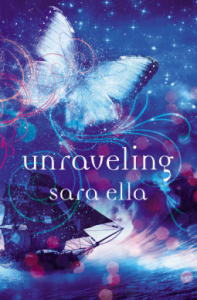
Sara Ella
Thomas Nelson – HarperCollins
Published July 11, 2017

Amazon | Barnes & Noble | Goodreads
About Unraveling
Eliyana Ember doesn’t believe in true love. Not anymore. After defeating her grandfather and saving the Second Reflection, El only trusts what’s right in front of her. The tangible. The real. Not some unexplained Kiss of Infinity she once shared with the ghost of a boy she’s trying to forget. She has more important things to worry about–like becoming queen of the Second Reflection, a role she is so not prepared to fill.
Now that the Verity is intertwined with her soul and Joshua’s finally by her side, El is ready to learn more about her mysterious birth land, the land she now rules. So why does she feel like something–or someone–is missing?
When the thresholds begin to drain and the Callings, those powerful magical gifts, begin to fail, El wonders if her link to Ky Rhyen may have something to do with it. For light and darkness cannot coexist. She needs answers before the Callings disappear altogether. Can El find a way to sever her connection to Ky and save the Reflections–and keep herself from falling for him in the process?
My Review
After reading Unblemished, I was super excited to get into this book. I liked the fresh story world and the spunky voice of Eliyana and all the musical references. All those great things continue in this second book. I loved the way some of the characters evolved– Ebony, especially– and enjoyed seeing Eliyana gain some confidence and independence of her own.
On the guy side… You know, in the first book, I was really rooting for Joshua and El to be together. I wasn’t a huge fan of Ky’s cockiness and attitude, and I liked Joshua’s self-sacrifice and commitment to do what was right no matter the personal cost to him. In this book, I found myself struggling to like either guy. I felt like they both had agendas, and while the story vilified one guy for his, I didn’t feel like I bought into the idea that the other guy should get off the hook because his motives were supposedly so pure.
I didn’t mind the lack of Christian worldview, but I felt like Unraveling confused some Christian concepts and warped them into a lot of gray morality. Everything seemed to come down to human strength. The good guys fight the Void and the bad guys simply aren’t strong enough to do so or flat out choose the darkness. I don’t know. It felt empty, I guess, and kind of arbitrary, if that makes any sense.
Despite my reservations about the characters, I definitely bought into the romance and want these guys to figure out some way to be happy. All of them. Some of Eliyana’s moments of comparison between how she feels about Joshua versus Ky made a lot of sense to me in terms of growing up and learning about love.
If you liked Cassandra Clare’s The Mortal Instruments series, you might like the world-jumping, star-crossed love elements of Unraveling. Definitely start the series with Unblemished, as it introduces a lot of characters gradually, and Unblemished kind of throws you right into the middle of a huge group of them without a lot of preamble. You can read my review of Unblemished here.
Cultural Elements
Major characters appear to be white. Some minor characters have darker skin tones.
Profanity/Crude Language Content
Story-centric curses, like crowe and Verity or Void.
Romance/Sexual Content
Eliyana is engaged to Joshua, but still has strong feelings for Ky. She exchanges kisses with the young man she loves. In one scene, it’s unclear how far the physical love goes. The man describes walking and kissing and ending up on his back, drawing her to him before the scene ends.
Kisses also create bonds and promises. A kiss to the heel of the palm can bind someone to a promise they’ve made, and cause their death if they break that promise. A Kiss of Infinity binds the soul of the giver to the receiver.
Spiritual Content
While the story flirts with some Christian concepts, occasionally referencing Proverbs or spiritual concepts, I wouldn’t say it holds a truly Christian worldview. The Verity represents light and good, and the Void represents darkness and sin, but each character who interacts with them makes choices based on his or her own strength to battle or join with those forces.
Many characters possess Callings, or special abilities, like healing or shape-shifting.
Violent Content
Eliyana, Joshua, and Ky’s bonds mean that when one experiences pain, the others often feel it. Battles include gunshot and arrow wounds as well as physical fights. Eliyana notices scars Ky carries and has a brief flashback about the torture he endured receiving them. She also experiences pain when she uses some of her gifts.
A young man kills a sleeping woman, justifying the death as self-defense, though it clearly isn’t. A soldier stabs a child through the heart with a sword. Another soldier dies protecting his wife.
Drug Content
Brief reference to a character who appears to be drunk.